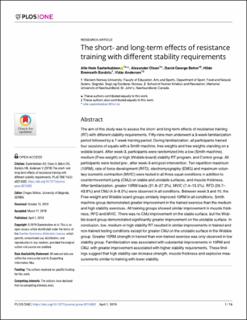| dc.contributor.author | Sæterbakken, Atle Hole | |
| dc.contributor.author | Olsen, Alexander | |
| dc.contributor.author | Behm, David G | |
| dc.contributor.author | Bårdstu, Hilde Bremseth | |
| dc.contributor.author | Andersen, Vidar | |
| dc.date.accessioned | 2020-03-25T08:19:05Z | |
| dc.date.available | 2020-03-25T08:19:05Z | |
| dc.date.created | 2020-01-01T10:23:08Z | |
| dc.date.issued | 2019 | |
| dc.identifier.citation | Sæterbakken, A. H., Olsen, A., Behm, D. G., Bardstu, H. B., & Andersen, V. (2019). The short- and long-term effects of resistance training with different stability requirements. Plos One, 14(4). | en_US |
| dc.identifier.issn | 1932-6203 | |
| dc.identifier.uri | https://hdl.handle.net/11250/2648473 | |
| dc.description.abstract | The aim of this study was to assess the short- and long-term effects of resistance training (RT) with different stability requirements. Fifty-nine men underwent a 3-week familiarization period followed by a 7-week training period. During familiarization, all participants trained four sessions of squats with a Smith machine, free weights and free weights standing on a wobble board. After week-3, participants were randomized into a low (Smith machine), medium (Free-weight) or high (Wobble board) stability RT program, and Control group. All participants were tested pre-, after week-3 and post-intervention. Ten repetition maximum (10RM), rate of force development (RFD), electromyography (EMG) and maximum voluntary isometric contraction (MVIC) were tested in all three squat conditions in addition to countermovement jump (CMJ) on stable and unstable surfaces, and muscle thickness. After familiarization, greater 10RM loads (21.8–27.3%), MVIC (7.4–13.5%), RFD (29.7–43.8%) and CMJ (4.9–8.5%) were observed in all conditions. Between week 3 and 10, the Free-weight and Wobble board groups similarly improved 10RM in all conditions. Smith machine group demonstrated greater improvement in the trained exercise than the medium and high stability exercises. All training groups showed similar improvement in muscle thickness, RFD and MVIC. There was no CMJ improvement on the stable surface, but the Wobble board group demonstrated significantly greater improvement on the unstable surface. In conclusion, low, medium or high stability RT resulted in similar improvements in trained and non-trained testing conditions except for greater CMJ on the unstable surface in the Wobble group. Greater 10RM strength in trained than non-trained exercise was only observed in low stability group. Familiarization was associated with substantial improvements in 10RM and CMJ, with greater improvement associated with higher stability requirements. These findings suggest that high stability can increase strength, muscle thickness and explosive measurements similar to training with lower stability. | en_US |
| dc.language.iso | eng | en_US |
| dc.publisher | PLoS | en_US |
| dc.rights | Navngivelse 4.0 Internasjonal | * |
| dc.rights.uri | http://creativecommons.org/licenses/by/4.0/deed.no | * |
| dc.subject | strength training | en_US |
| dc.subject | electromyography | en_US |
| dc.subject | muscle analysis | en_US |
| dc.subject | knees | en_US |
| dc.subject | legs | en_US |
| dc.subject | muscle contraction | en_US |
| dc.subject | signal filtering | en_US |
| dc.subject | hand strength | en_US |
| dc.title | The short and long-term effects of resistance training with different stability requirements | en_US |
| dc.type | Peer reviewed | en_US |
| dc.type | Journal article | en_US |
| dc.description.version | publishedVersion | en_US |
| dc.rights.holder | © 2019 Saeterbakken et al. | en_US |
| dc.subject.nsi | VDP::Medisinske Fag: 700::Idrettsmedisinske fag: 850::Treningslære: 851 | en_US |
| dc.source.pagenumber | 1-18 | en_US |
| dc.source.volume | 14 | en_US |
| dc.source.journal | PLOS ONE | en_US |
| dc.source.issue | 4 | en_US |
| dc.identifier.doi | 10.1371/journal.pone.0214302 | |
| dc.identifier.cristin | 1764641 | |
| cristin.ispublished | true | |
| cristin.fulltext | original | |
| cristin.qualitycode | 1 | |

